Introduction
The Country Analysis
Country analysis underlies many a political and commercial decision, not least because of the realities of geopolitical alliances, the globalization of supply chains and markets, and even simple trade in finished goods. Governments, financial institutions and industry all need to discern or update themselves on the reliability and stability of their counterparts in other nations and the long-term prospects for.
Accordingly, country analysis typically embraces an extensive range of political, macroeconomic, domestic business prospects, and cultural factors (Economist Intelligence Unit, 2008) such as:
- The structure of the economy: leading industrialized nation, less developed country, agricultural economy, destabilized by insurgency and conflict, etc.
- An overview of macroeconomic fundamentals and political developments since government is such an active participant in mitigating or aggravating the business environment. Since the current recession commenced, for instance, fiscal policy in the United States, the U.K., Australia, Japan, Germany, Australia and France have all been heavily skewed towards ameliorating the worst effects of an economic downturn. Or at least being seen to inspire confidence that an upturn is in sight.
- The near-term outlook for politics, economics, the domestic business environment, foreign trade, balance of payments, and exchange rate trends, among others. Given how dynamically all such factors behave, constant updates are crucial. Two months ago, for example, no one could have predicted that the party of current Prime Minister would upset the longstanding monopoly of the Liberal Democratic Party and forthwith distance the nation from the U.S. and the fight against the Taliban in Japan, despite the fact that the island nation depends heavily on America for trade.
- A “long view” analysis of production, prices, inflation, exchange rates, loans, retail sales, imports and exports, and foreign direct investment with a view to building models for predicting near- and medium-term change.
Purpose of the Analysis
For any given country analysis, the emphasis will likely depend on the purpose for which it is developed. In broad terms, country analysis seeks to minimize risk by spotlighting opportunities and drawbacks for any investment of political goodwill, human capital and financial assets.
For one, multilateral funding institutions and regional development banks may be concerned with the future potential of an economy currently sunk in a morass of external shocks, recession, and significant exchange rate instability. The International Monetary Fund may well remain wary of South Africa repeating the foreign debt crisis of 1985 when foreign banks like Chase Manhattan refused to rescheduled $14 billion of debt.
A second purpose for embarking on country analysis is when foreign direct investors wish to explore putting up subsidiaries in Japan and South Africa. In that case, the analysis will put priority on restrictive labor laws (e.g. favoring indigenous peoples in South Africa), policies about profit repatriation, and openness of local industrial/consumer markets to foreign-brand suppliers (non-tariff barriers being a fact of life in Japan, for instance).
Brief on Countries
Japan and South Africa present contrasting pictures. Where one is a monolithic dynamo of world commerce and unsullied by colonization, South Africa has surged to become the largest economy in the African Union, industrialized-nation status with the Group of 20 (and even the G-8 plus 5) despite centuries of colonization, of ethnic, linguistic and religious diversity.
Except for coal and marine life, Japan has virtually no natural resources. After the Meiji restoration and the forced opening up to foreign contact and trade, Japan strove for a larger presence on the world stage. Early in the last century, the nation showed its mettle by beating Russia (many times its size) at Tsushima and Port Arthur. Japan enslaved Korea and Manchuria prior to conquering all of east Asia in World War II. Defeated in 1945, the Japanese scrambled back to become the second largest economy around the globe by late in the 20th century, yielding that status to China only in recent years.
Like Japan, South Africa already boasted recognizably human habitation for at least 100,000 years, back to the Late Stone Age. The early Bushmen, joined by Xhosa and Zulu immigrants from elsewhere in central and eastern Africa, came under Dutch Boer and English rule principally because of the nation’s strategic location on the sea routes between Europe, India and the Far East. The discovery of rich gold deposits in 1886 and subsequently, diamonds and uranium launched this largely arid country toward the bustling industry and trade it enjoys in contemporary times. The political compromises and fragmentation of South Africa are best illustrated by the fact that the three branches of government are dispersed throughout Bloemfontein (the judiciary), Pretoria (the executive) and Cape Town (the legislature), none of them being anywhere as large as Johannesburg.
Discussion of Forthcoming Chapters
Section 2 below reprises the political and socio-economic information about both Japan and South Africa. Subsequently, section 3 discusses the purposes of economic analyses in greater detail and compares the performance of both nations on every important indicator of macroeconomic performance. This is followed by a comparative scrutiny in section 4 of the comparative advantages inherent in geographic location, domestic resources, human and social capital. Finally, section 5 introduces the regression-based estimate of gross domestic product and per-capita income for the two nations involved, together with a reappraisal of critical strengths, opportunities and weaknesses.
The Countries
Political Information
The emergence of the Democratic Party of Japan’s Yukio Hatoyama as the new Prime Minister in elections for the Lower House last August brought to a head dissatisfaction with the decades-long monopoly of the Liberal Democratic Party and with the recession – the second the nation experienced in less than two decades – that triggered homelessness and record unemployment. For the first time, a G-8 leader admitted what decades of apparently-isolated bribery scandals had already made obvious: corruption was rife in the government bureaucracy and willing “donors” among the great zaibatsu were responsible. This is old news in Asia. From South Korea to mainland China, Hong Kong, the Republic of China, Thailand, the Philippines and Indonesia, Presidents, Dictators-for-Life and Prime Ministers had been unseated and even jailed for massive graft in modern (postwar) times. The difference was that an advanced, industrialized country like Japan admitted to losing untold trillions of yen to bureaucrats and “sararimen”, funds that could otherwise have gone to pump-priming the economy in the last two recessions. The newly-dominant DPJ now hopes to halt these revenue losses to have funds for, among others, unemployment benefits and incentives to married couples to have more children.
In quick succession, Hatoyama also moved to loosen dependence on America as a signal to the electorate that the nation could no longer rely on the United States to be the global engine of growth through the massive trade deficits the U.S. ran year after year with both China and Japan. Perhaps, the initial moves seemed cosmetic: refusing to renew the lease on an airbase in Okinawa and withdrawing even the token presence of refueling tankers that serviced Coalition navies still involved in Afghanistan. Certainly, Japan may seek closer ties with Russia and China but is unlikely to ally itself overnight with rash states like North Korea or Iran. Nevertheless, the publicly-declared autonomy of the Japanese government could not have failed to dismay a U.S. president who arrived in Tokyo for bilateral talks in early November still talking up the idea of sending more American ground troops to Afghanistan.
The problem of Japan is that it truly has no natural resources of its own and must depend on trading partners for both access to raw materials and markets for its finished goods. Meanwhile, there is East Asia where countries like the Philippines and China proved more resilient in not skidding into outright recession as Japan, Europe, Australia and North America did commencing the second half of 2007. But the fact is, Japan had never neglected East Asia. While still paying reparations for war damages after World War II, Japan was already exporting the first generation of Toyotas to the resource-rich economies of the region as a test bed for invading the biggest automobile market on earth.
Despite official pronouncements that the Japanese economy began a definite rebound in August this year, the new leadership needs to condition its constituents that the era of export-led growth may never return. Perhaps there will be trade opportunities with massive Chinese market. But People’s China has already reached the stage of import-substituting industrialization that signaled the emergence of South Korea. Therefore, Hatoyama needs the Japanese to rally behind him in “trickle-up” economics, the belief that increasing the disposable income of the man on the street (and even reducing the remarkable savings rate) will so strengthen domestic demand this will replace some of the growth impetus that consistently massive export surpluses used to provide.
While Japan has had the advantage of cohesiveness in ethnicity, language, the Shinto “religion”, and obeisance to the emperor, South Africa has been distinctly hampered by being effectively a fledgling, freely elected democratic government. This political status resembles emergent or less-developed economies more than the reality of having attained “Group of 20” status.
The African National Congress of Nelson Mandela has been in power all of fifteen years, since 1994 when the first free elections post-apartheid were held. For far too long, the history of South Africa has been marked by distrust among the indigenous Bantu, invading tribes from the north and east, the Dutch Calvinist Boers who came to stay and the British who first wrested control of the country’s mineral wealth.
Though the Portuguese were the first Europeans to reach what they initially named the “Cape of Storms” (later, the “Cape of Good Hope”), it was the Dutch who established a permanent refreshment station nearly a century late, in 1652. From then on till 1994, the socio-political situation was predominantly one of White interlopers pushing back the Blacks and Coloreds, subjugating and enslaving them.
For the most part, external developments and pressure paved the way to eventual accession by the African majority to self-rule. For example, it was abolitionist sentiment in the home country that led to official bans on slavery within three decades of the British landing in the Cape Colony. But Blacks who had known no other life elected to stay with their former masters, albeit as “employees” paid large in kind.
And the road forward remained rocky. Early in the 20th century, the White minority government passed the Native Lands Act, which not only placed severe restriction on native ownership of land but also institutionalized segregation of the population. Blacks and Coloreds could work in the cities but they had to return to their assigned communities every evening and this held as well for imported Chinese and Indian labor. Post World War II, the National Party (that had never wanted to fight side by side with the British in the war) strengthened what became known as apartheid. Eventually, the combination of international sanctions and local resistance brought the Party to the negotiating table in 1990. Apartheid was repealed, a “Convention for a Democratic South Africa” commenced and free elections held. Known worldwide for his long incarceration as a “prisoner of conscience,” Nelson came into power in 1994 and remains head of state till the present.
Socio-Economic Information
The diverse and often-explosive mix of peoples that is South Africa contrasts sharply with the homogenous people and culture of Japan. In addition, health status and income distribution heighten the differences in this country analysis.
South Africa has 11 official languages, all recognized in the constitution. English is common in official and business communication but there is also Afrikaans, Southern Ndebele, Northern and Southern Sotho, the Swazi and Zulu of the Zulus, Tsonga, Tswana, Vendam, and Xhosa. In contrast, Nippon has at most two dialects of the Japanese language and the indigenous darker people but these are a tiny minority. Virtually all Japanese (98.5%) belong to one common genetic stock (CIA, 2009a; 2009b).
South Africa has a sizeable White, Indian and half-breed minorities against a backdrop of 80% Black population. As attested to by the different official languages, however, such “native” ethnicity is a veritable rainbow of many different tribes that have historically been at odds with each other.
The UNDP (2009) rates Japan among the 38 nations that demonstrate “very high human development indices (HDI)” while consigning South Africa to the mediocre ranks of “medium human development”. One very telling indicator of this is the GINI coefficient for income distribution. It is 38.1 (good to very good) in Japan, even better than the 46.3 recorded for the United States in 2007. In South Africa, in contrast, the 25% unemployment rate and low per-capita income for the country as a whole makes for a worrisome GINI of 57.8 as of 2000.
Among the reasons why Japan ranks 10th in the world in HDI as of 2007 is a very advanced and comprehensive health care system, on a par with those of the most advanced industrialized nations. Thus, both national and local governments pay for healthcare services, there is employer-paid health insurance, and those not so covered (including the elderly) can avail of the national health insurance program, all within the context of a universal health care insurance system. There is no such provision in South Africa where life expectancy at birth is dreadfully short at 49 years for males and 48 for women on account of communicable diseases that run rife: bacterial diarrhea, hepatitis A, and typhoid fever. Even worse, the plague of AIDS that is the scourge of sub-Saharan and East Africa also cuts an ominous swath through the population. After a long period when the Mandela government denied the prevalence of HIV, it has finally been revealed that up to 31% of pregnant women are HIV carriers and the annual infection ratio among sexually active adults stands at one in five as of 2005.
Economic Analysis
The Purpose of an Economic Analysis
In brief, the purpose of an economic analysis is the aforementioned risk reduction and the need to protect investments in trans-border or overseas markets from unanticipated movements in the macroeconomic and political environments (Baye, 2008; Ajami, Cool, and Goddard, 2005). A side by side analysis of the economic conditions in the two countries is helpful in determining the extrinsic and intrinsic reasons for the two countries situation
Country Performance Indicators
Macro Performance: GDP, GNE, HFCE, Pop

The Gross Domestic Product or GDP is the basic measurement of a country’s comprehensive economic performance. The GDP represents the net market value of all the goods and services made within a country over the period of one year. A high GDP is suggestive of a high standard of living. However, the use of GDP as a stand in for standard of living has been questioned by some sectors. The GDP is also a good indicator of the overall market in a country. The most common method of computing the GDP is via the expenditure method which involves getting the sum of all private consumption, gross investments, government spending and exports less imports.
The economy of Japan is the second largest economy in the world with a nominal GDP of around $ 5 Trillion. In the 60s Japan’s GDP has grown at a steady clip of 10% annually. This went down to 5% in the 70s then 4% in the 80s before the onset of what would become a decade long recession. From 1991-1999 GDP grew by a mere 1.5% in contrast to the rapid growth of the previous decades.
The 2008 GDP of South Aftica is $277 billion or approximately 0.45% of the world economy. It is a two tiered economy where one side is highly developed while the other contains mostly basic infrastructure. There exists a primary sector which is largely based on manufacturing, the services industry, mining and large scale agriculture. It s well developed. A secondary economy consisting of subsistence agriculture is poorly developed and usually excluded from economic measurements. The primary sector has contracted by 2.8% in the last two quarters as the world wide recession grips South Africa.
A quick glance at the graph will indicate that the GDP of the Japan is clearly much larger than that of South Africa. However, the GDP discrepancy is influenced by several factors. First, Japan has a much larger population than South Africa which contributes which when related to its high standard of education and higher level of industrialization it is not unimaginable that the country as a whole would be more developed and more productive. Second, South Africa only recently, in the 90s, ended the practice of Apartheid which contributed to the slow growth of their real economy. Between the two countries, the largely export based economy of South Africa is more vulnerable to the recession.
Gross Capital Expenditure
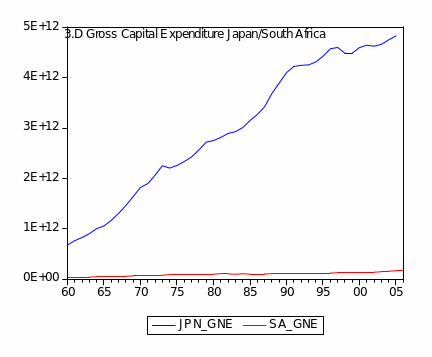
The Gross Capital Expenditure is a measure of the total amount the government spent in a country as reported to the proper government agency. The Gross Capital Expenditure of the two countries corresponds closely to the gross domestic product of the two countries. Japan’s GCE is much higher than that of South Africa because of the lower GDP of South Africa. Thus, the reasons for the discrepancy in GDP also apply in GCE.
Household Financial Consumption Expenditure
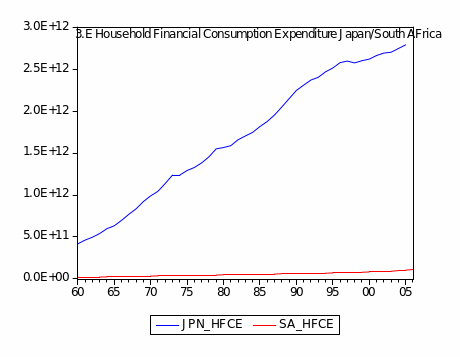
The Household Financial Consumption Expenditure is the measure of the total amount spent by all households in a country for a given year. The Household Financial Consumption Expenditure of Japan is significantly higher than its correlative in South Africa. This is in part due to the great disparity in per capita income between the two countries. Japan’s per capita income, at $34,115, is almost six times higher than South Africa’s ($5,684). Another influence is the consumerist culture of Japan where people are driven to obtain the latest in all things.
It can be noted that during the period between 1995 and 2000 Japanese HFCE stagnated as a response to the economic slowdown that Japan was suffering at that time. South African HFCE has been steady for the entire period. Furthermore, South African’s HFCE has been steadily growing since the 1960s.
- Sector Performance: Value Added: Agriculture, Industry, Manufacturing, and Services
- Trade Performance: Exports, Imports and Net Exports
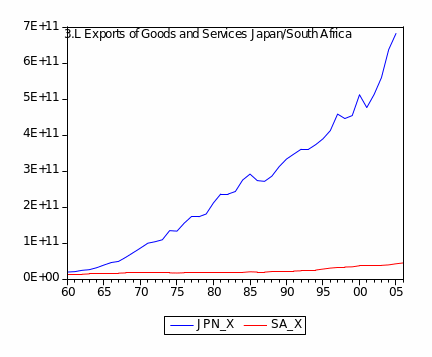
Japan’s exports are constant for the entire period covered, with minor dips. Between 2000 and 2005 Japan’s exports seemed to skyrocket. This is proof that Japan’s manufactured goods are still fit for export to other countries despite heavy competition from China. There is still a market for Japanese goods despite the availability of cheaper substitutes. However, the recession has had a negative impact on Japan’s total exports in recent years. South Africa’s chief exports, gold and diamonds are always needed by the world hence even during economic downturns South Africa’s exports remain constant.
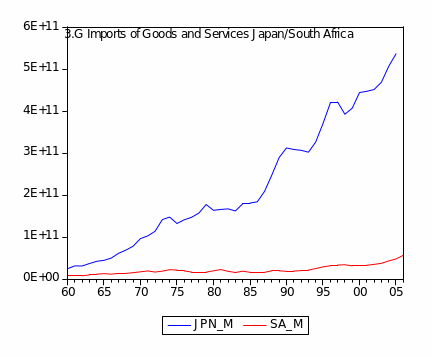
Japan lacks many of the natural resources it needs for its industries. Consequently it has to import these from foreign countries. As a result during periods of high economic activity Japan’s imports are also very high reflecting its need for raw materials. During periods of economic slow down, imports are one of the first things to be cut back.
Investment: FDI and GCF
Foreign Direct Investment
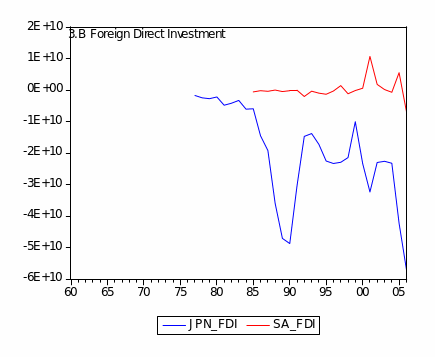
Foreign Direct Investment refers to foreign companies making physical investments in a given country. Commonly, this involves establishing a factory or a business in that country. Foreign Direct Investment is that mechanism of cross-border corporate control by which the foreign company gains control of assets in another country via its investment. A Foreign Direct Investment involves the parent company, usually a multinational corporation, setting up a branch in the country where the investment is being done. In order for an investment to qualify as a Foreign Direct Investment the Parent firm must own a controlling interest in the local affiliate. Usually a controlling interest is defined as 10% ownership.
Foreign Direct Investment in Japan is virtually non-existent while there is a modest FDI in South Africa.
The dynamics of the Japanese economy coupled with its relative lack of exploitable natural resources means that foreign companies are not likely to invest in Japan. For one, most natural resources in Japan are already being exploited by locally owned firms. Second, Japan has one of the highest labor costs in the world making any FDI in manufacturing highly unprofitable especially with China being so close by. Finally the negative FDI also refers to Japan’s own Foreign Direct investment in other countries.
South Africa is the diamond capital of the world. The bans against South Africa due to its practice of Apartheid have only been recently lifted. Unlike Japan South Africa still has underdeveloped natural resources which can be exploited.
Gross Capital Formation
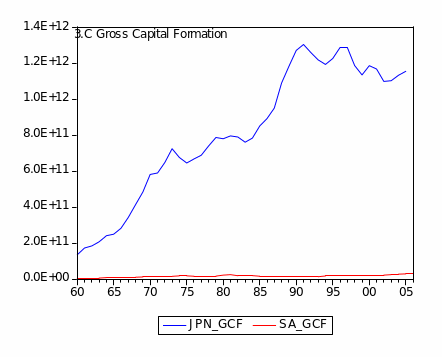
Gross Capital Formation is the measure of the total new investments in fixed capital assets within a domestic year. These investments can be made by corporations, government or even households. It is not a measure of total investment.
The lackluster GCF of South Africa is again a function of its small size economically when compared to Japan. Japan’s GCF has been fluctuating in pace with the world economy. For instance it is noticeable GCF decreased during the long period of economic decline during the 1990s. It also declined during the period of world wide economic decline during the 70s and early 80s when Oil prices skyrocketed. GCF appears to be sensitive to world economic conditions because Japan’s GCF declines during world wide economic declines.
References
Ajami, R. A., Cool, K. & Goddard, G. J. (2005). International business: Theory and practice. Armonk, NY: M. E. Sharpe, Inc.
Baye, M. (2008). Managerial economics and business strategy. New York: McGraw-Hill Irwin.
Central Intelligence Agency (2009a). The World Factbook: Japan. Web.
Central Intelligence Agency (2009b). The World Factbook: South Africa. Web.
Economist Intelligence Unit (2008). Country analysis and forecasts. Web.
UNDP (2009). Statistics of the Human Development Report. Web.
